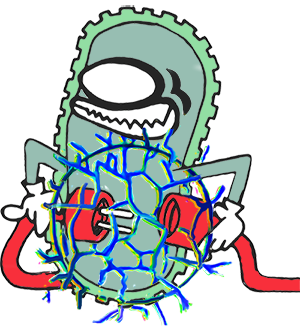Team:TU Delft-Leiden/Project/Life science/EET/cloning
From 2014.igem.org
Module Electron Transport - Cloning
click to return to the Module Electron Transport
Final constructs
The final BioBricks constructed for this module were:mtrCAB and mtrCAB-His
ccmAH
mtrCAB and mtrCAB-His
Final constructs
The two BioBricks constructed using the mtrCAB genes were BBa_K1316012 and BBa_K1316017 (figures 1 and 2).

Cloning Scheme
The template used to obtain the mtrCAB genes was the Ajo-Franklin plasmid [1], from which 5 different pairs of primers were designed to eliminate the main iGEM illegal restriction sites by means of the Golden Gate Assembly method.
To generate BBa_K1316017 (construct with mtrCAB-His), the last reverse primer was designed in a way that a 6 x His tag was introduced at the C-terminus of the MtrB protein. This tag aims to be able to easily detect and purify this protein.
Once the 5 fragments were PCRed, they were assembled together via the Golden Gate Assembly method. The Golden Gate primers were designed so that, due to the used BsaI enzyme, at the end of this assembly the 5' end of the assembled construct was compatible with a fragment restricted with EcoRI and the 3' end with a fragment restricted with SpeI. Consequently, the Assembled fragment was compatible with an iGEM backbone restricted with the enzymes EcoRI and SpeI. This way, the assembled construct was introduced into the pSB1C3 iGEM backbone.
Later on, the mtrCAB BioBricks (BBa_K1316012 and BBa_K1316017) were introduced into pSB3K3, because it is a backbone with a much lower copy number than pSB1C3, and in the literature the mtrCAB genes were found to be quite toxic for Escherichia coli.
A more graphical representation of the cloning strategy can be found on figure 3.
Important notes

ccmAH
Final constructs
The BioBrick constructed using the ccmAH gene cluster is BBa_K1316011 (figure 4).

Cloning Scheme
The BioBrick BBa_K1316011 was built up by amplifying the best performing promoter according to Goldbeck [1] and introducing it upstream de coding region of the ccmAH cluster of the Biobrick BBa_K917006 constructed by the iGEM team Edinburgh 2012, which was already BioBrick compatible.
A more graphical representation of the cloning strategy can be found on figure 5.

References
[1] C.P. Goldbeck, H.M. Jensen et al., “Tuning Promoter Strengths for Improved Synthesis and Function of Electron Conduits in Escherichia coli”, ACS Synth. Biol. 2, 150-159, 2013.
 "
"






